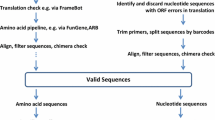Abstract
The incidence and diversity of methanogens in Priest Pot, a dynamic and active lake, were monitored by analysing mcrA gene sequences generated from total DNA samples obtained at different times of the year and amplified using the polymerase chain reaction. A number of mcrA clones were analysed by developing an RFLP-based protocol to generate a number of restriction patterns that were assigned to a number of classes. The RFLP patterns for each class were compared with published sequence information for mcrA from cultured methanogens as well as with those from other experimental studies. They could be used to assign tentative identification for some of the Priest Pot clones and also revealed the presence of a number of clones that could not be affiliated to any known methanogens. The limitations of using RFLP profiles of mcrA gene sequences for studying methanogen ecology are discussed.
Similar content being viewed by others
References
Berninger UG, Wickham SA, Finlay BJ (1993) Trophic coupling within the microbial food web: a study with fine temporal resolution in a eutrophic ecosystem. Freshwat Biol 30:431–432
Bidle KA, Kastner M, Bartlett DH (1999) A phylogenetic analysis of microbial communities associated with methane hydrate containing marine fluids and sediments in the Cascadia margin (ODP site 892B). FEMS Microbiol Lett 177:101–108
Bokranz M, Klein A (1987) Nucleotide sequence of methyl coenzyme M reductase gene cluster from Methanosarcina barkeri. Nucleic Acids Res 15:4350–4351
Bokranz M, Baumner G, Allmansberger R, Ankel-Fuchs D, Klein A (1988) Cloning and characterization of the methyl coenzyme M reductase genes from Methanobacterium thermoautotrophicum. J Bacteriol 170:568–577
Casper PC, Maberly SC, Hall GH, Finlay BJ (2000) Fluxes of methane and carbon dioxide from a small productive lake to the atmosphere. Biogeochemistry 49:1–19
Cram DS, Sherf BA, Libby RT, Mattaliano RJ, Ramachandran KL, Reeve JN (1987) Structure and expression of the genes, mcrBDCGA, which encode the subunits of component C of methyl coenzyme reductase in Methanococcus vannielii. Proc Natl Acad Sci 84:3992–3996
Edwards U, Rogall T, Blocker H, Emde M, Bottger EC (1989) Isolation and direct complete nucleotide determination of entire genes—characterisation of a gene encoding 16S-ribosomal RNA. Nucleic Acids Res 17:7843–7853
Embley TM, Finlay BJ (1994) The use of small subunit rRNA sequences to unravel the relationship between anaerobic ciliates and their methanogenic endosymbionts. Microbiology 140:225–235
Felsenstein J (1993) PHYLIP—phylogeny inference package. Department of Genetics, University of Washington, Seattle, WA
Finlay BJ, Maberly SC (2000) Microbial diversity in Priest Pot: A productive pond in the English lake district. Titus Wilson and Sons, Kendal, UK
Fitch WM (1971) Toward defining the course of evolution minimum change for a specific tree topology. Syst Zool 20:406–416
Grabarse W, Shima S, Mahlert F, Duin EC, Thauer RK, Ermler U (2001) Methyl-coenzyme M reductase. In: Messerschmidt A, Huber R, Poulos T, Wieghardt K (Eds.) Handbook of Metalloprotiens. John Wiley & Sons, Chichester, UK, pp 897–914
Hales BA, Edwards C, Ritchie DA, Hall G, Pickup RW, Saunders JR (1996) Isolation and identification of methanogen-specific DNA from blanket bog peat by PCR amplification and sequence analysis. Appl Environ Microbiol 62:668–675
Hall GH, Simon BM, Pickup RW (1996) CH4 production in blanket bog peat: a procedure for sampling, sectioning and incubating samples whilst maintaining anaerobic conditions. Soil Biol Biochem 28:9–15
Heaney SI (1974) A pneumatically-operated water sampler for close intervals of depth. Freshwat Biol 4:103–106
Houghton JT, Jenkins GJ, Ephraums JJ (1990) In: Houghton JT, Jenkins GJ, Ephraums JJ (Eds.) Climate Change: the IPCC Scientific Assessment (by) the Intergovernmental Panel on Climate Change Cambridge University Press, Cambridge, UK, pp 1–41
Jukes TH, Cantor CR (1969) Evolution of protein molecules. In: Munro NH (Eds.) Mammalian Protein Metabolism. Academic Press, New York, pp 21–132
Leuders T, Chin KJ, Conrad R, Friedrich M (2001) Molecular analysis of methyl-ceoenzyme M reductase α-subunit mcrA genes in rice field soil and enrichment cultures reveal the methanogenic phenotype of a novel archaeal lineage. Environ Microbiol 3:194–204
Ohnstad FR, Jones JG (1982) The Jenkin surface mud sampler. Freshwater Biological Association Annual Report 15. Ambleside, UK
Pearman GI, Fraser PJ (1988) Sources of increased methane. Nature 332:489–490
Ramakrishnan B, Leuders T, Dunfield PF, Conrad R, Friedrich MW (2001) Archaeal community structure in rice soils from different geographical regions before and after initiation of methane production. FEMS Microbiol Ecol 37:175–186
Ritchie DA, Edwards C, McDonald IR, Murrell C (1997) Detection of methanogens and methanotrophs in natural environments. Global Change Biol 3:339–350
Sitzmann J, Kelin A (1991) Physical and genetic map of Methanococcus voltae chromosome. Mol Microbiol 5: 505–513
Springer E, Sachs MS, Woese CR, Boone DR (1995) Partial gene sequences for the A subunit of methyl coenzyme M reductase (mcrl) as a phylogenetic tool for the family Methanosarcinaceae. Int J Syst Bacteriol 45:554–559
Upton M, Hill B, Edwards C, Saunders JR, Ritchie DA, Lloyd D (2000) Combined molecular ecological and confocal laser scanning microscopic analysis of peat bog methanogen populations. FEMS Microbiol Lett 193:275–281
Weil CF, Cram DS, Sherf BA, Reeve JN (1998) Structure and comparative analysis of the genes encoding component C of methyl coenzyme reductase in extremely thermpohilic archaeabacterium Methanothermus fervidus. J Bacteriol 170:4718–4726
Woese CR (1987) Bacterial evolution. Microbiol Rev 51: 221–271
Author information
Authors and Affiliations
Corresponding author
Additional information
Online publication: 13 June 2003
Rights and permissions
About this article
Cite this article
Earl, J., Hall, G., Pickup, R.W. et al. Analysis of methanogen diversity in a hypereutrophic lake using PCR-RFLP analysis of mcr sequences. Microb Ecol 46, 270–278 (2003). https://doi.org/10.1007/s00248-003-2003-x
Received:
Accepted:
Issue Date:
DOI: https://doi.org/10.1007/s00248-003-2003-x




